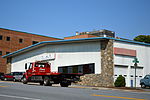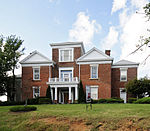Clingman Avenue Historic District
African-American history of North CarolinaBuildings and structures in Asheville, North CarolinaBuncombe County, North Carolina Registered Historic Place stubsHistoric districts on the National Register of Historic Places in North CarolinaHouses in Buncombe County, North Carolina ... and 5 more
Houses on the National Register of Historic Places in North CarolinaNRHP infobox with nocatNational Register of Historic Places in Buncombe County, North CarolinaQueen Anne architecture in North CarolinaUse mdy dates from August 2023

Clingman Avenue Historic District is a national historic district located at Asheville, Buncombe County, North Carolina. The district encompassed 33 contributing buildings in a historically African-American residential section of Asheville. It was largely developed in the early-20th century and includes representative examples of Queen Anne and Bungalow style dwellings.It was listed on the National Register of Historic Places in 2004.
Excerpt from the Wikipedia article Clingman Avenue Historic District (License: CC BY-SA 3.0, Authors, Images).Clingman Avenue Historic District
Rector Street, Asheville
Geographical coordinates (GPS) Address Nearby Places Show on map
Geographical coordinates (GPS)
| Latitude | Longitude |
|---|---|
| N 35.59 ° | E -82.563333333333 ° |
Address
Rector Street 92
28801 Asheville
North Carolina, United States
Open on Google Maps









